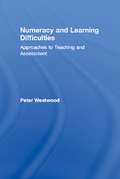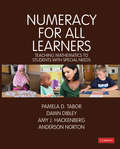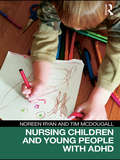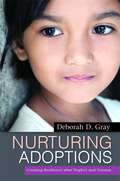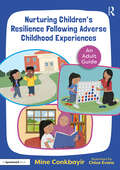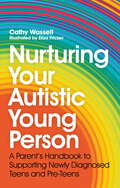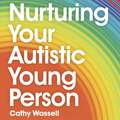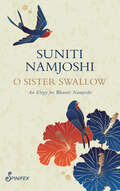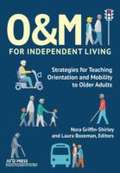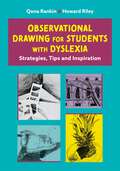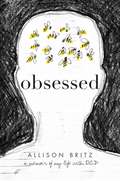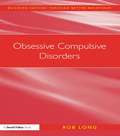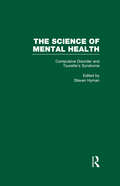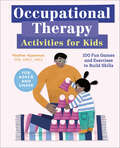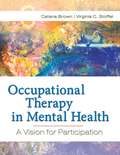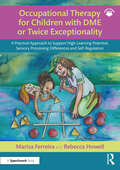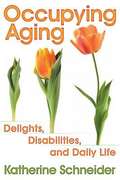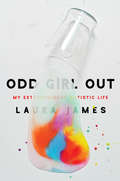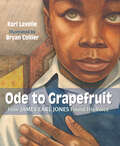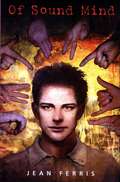- Table View
- List View
Numeracy and Learning Difficulties: Approaches to Teaching and Assessment (Learning Difficulties Ser.)
by Peter WestwoodBy understanding why children struggle with maths, teachers are better equipped to provide effective support and nurture confidence in low-achievers. Numeracy and Learning Difficulties includes how to tackle common learning difficulties by following different teaching practices and principles, identifying gaps in students' knowledge and developing curricula that bridges these gaps, improves numerical literacy using problem-solving strategies and skills, and a handy checklist of benchmarks in achievement.
Numeracy for All Learners: Teaching Mathematics to Students with Special Needs (Math Recovery)
by Pamela D Tabor Anderson Norton Amy J Hackenberg Dawn DibleyNumeracy for All Learners is a wide-ranging overview of how Math Recovery® theory, pedagogy, and tools can be applied meaningfully to special education to support learners with a wide range of educational needs. It builds on the first six books in the Math Recovery series and presents knowledge, resources, and examples for teachers working with students with special needs from Pre-K through secondary school. Key topics include: dyscalculia, what contemporary neuroscience tells us about mathematical learning, and differentiating assessment and instruction effectively to meet the needs of all students in an equitable framework.
Numeracy for All Learners: Teaching Mathematics to Students with Special Needs (Math Recovery)
by Pamela D Tabor Anderson Norton Amy J Hackenberg Dawn DibleyNumeracy for All Learners is a wide-ranging overview of how Math Recovery® theory, pedagogy, and tools can be applied meaningfully to special education to support learners with a wide range of educational needs. It builds on the first six books in the Math Recovery series and presents knowledge, resources, and examples for teachers working with students with special needs from Pre-K through secondary school. Key topics include: dyscalculia, what contemporary neuroscience tells us about mathematical learning, and differentiating assessment and instruction effectively to meet the needs of all students in an equitable framework.
Nursing Children and Young People with ADHD
by Tim McDougall Noreen RyanADHD is one of the most commonly diagnosed behavioural disorders in children and young people. It is a complex and contested condition, with potential causes and treatments in biological, psychological and social domains. This is the first comprehensive text for nurses and other health professionals in this field. Nursing Children and Young People with ADHD explores the evidence, incorporating and expanding on the new NICE guidelines for practice in this area, to provide an essential knowledge base for practice. The text covers: causes, diagnosis, co-morbidity, user and carer perspectives, assessment, treatment and interventions (including those suitable for use in schools), prescribing and the legal background. An invaluable text for pre-registration student nurses on mental health and children branches, this will also be a useful reference work for post-registration nurses and health professionals seeking evidence-based recommendations for practice.
Nurturing Children's Resilience Following Adverse Childhood Experiences: An Adult Guide (Maya's ACE Adventures!)
by Mine ConkbayirFor effective use, this book should be purchased alongside the accompanying storybook, Maya’s ACE Adventures!: A Story to Celebrate Children’s Resilience following Adverse Childhood Experiences [9781032368177]. Both books can be purchased together as a set, Helping Children to Thrive After Adverse Childhood Experiences: ‘Maya’s ACE Adventures!’ Storybook and Adult Guide [9781032367934]. Alongside the accompanying storybook, Maya’s ACE Adventures!, this guide provides adults with much-needed resources to talk to children about their traumatic experiences in ways that are non-threatening, safe, and can build a child’s confidence in speaking about their fears with a trusted adult. Designed to be read by an adult before they read the story together with a child, the guide provides practical tools, such as scene-by-scene discussion prompts and strategies for co-regulation, to facilitate conversations that are informed, relaxed and allow for healing from grief and trauma. These tools are contextualised by a detailed examination and critique of the Adverse Childhood Experiences (ACEs) framework, in addition to an overview of the neurobiology involved in the stress response, to support adults and alleviate their anxiety about asking the right questions and having the rights answers for the children they support. Together with the storybook, this guide is essential reading for teachers, parents, foster carers, social workers, and other professionals who are supporting children, by giving them the resources they need to foster hope and resilience among children who have survived traumatic experiences.
Nurturing Your Autistic Young Person: A Parent’s Handbook to Supporting Newly Diagnosed Teens and Pre-Teens
by Cathy WassellAs the parent of a child recognised as autistic as a pre-teen or teen, it can often feel difficult to find the answers you need. Children who make it to late primary/early secondary age before being picked up by the system tend to present with traits that are harder to spot, meaning it can be harder to engage professionals in the diagnostic process and gather the necessary support.Cathy Wassell, CEO of Autistic Girls Network, has tailored this handbook to support parents with older children or teenagers who are at the identification stage, walking them through the basics in an engaging and accessible manner. She addresses key challenges for this age group, including co-occurring conditions, puberty, and safeguarding, as well as looking to the future, advising on schooling options, and beyond.Designed to help parents become fully informed and ensure a nurturing and positive environment for our autistic young people, this is a guide with a focus on difference - not deficit.
Nurturing Your Autistic Young Person: A Parent’s Handbook to Supporting Newly Diagnosed Teens and Pre-Teens
by Cathy WassellAs the parent of a child recognised as autistic as a pre-teen or teen, it can often feel difficult to find the answers you need. Children who make it to late primary/early secondary age before being picked up by the system tend to present with traits that are harder to spot, meaning it can be harder to engage professionals in the diagnostic process and gather the necessary support.Cathy Wassell, CEO of Autistic Girls Network, has tailored this handbook to support parents with older children or teenagers who are at the identification stage, walking them through the basics in an engaging and accessible manner. She addresses key challenges for this age group, including co-occurring conditions, puberty, and safeguarding, as well as looking to the future, advising on schooling options, and beyond.Designed to help parents become fully informed and ensure a nurturing and positive environment for our autistic young people, this is a guide with a focus on difference - not deficit.
O Sister Swallow: An Elegy for Bharati Namjoshi
by Suniti NamjoshiShouldn' t there be a bridge from the known to the unknown?In this exquisite elegy, Suniti Namjoshi reflects on the life of her sister Bharati, their overlapping yet disparate lives, their nearness and distance, and what it means to belong and to be valued. The two sisters love one another and they love birds; but they live on different continents and think in different languages. Is this what sisterhood is really about – to acknowledge difference and still to understand and to care?This richly textured book with its tender and elegant language is full of both joy and grief. It is a generous yet poignant invitation from the author to us to contemplate our own experience.If the casual, implacable insolence of death could be answered by building a monument or by writing an elegy, perhaps it would do till language crumbled and the edifice fell.
O&M for Independent Living: Strategies for Teaching Orientation and Mobility to Older Adults
by Nora Griffin-Shirley Laura BozemanThis text is a guide for orientation and mobility instructors, rehabilitation specialists, occupational therapists, and other professionals who work with older people who may be new to vision loss.
Observational Drawing for Students with Dyslexia: Strategies, Tips and Inspiration
by Qona Rankin Howard RileyThis hands-on practical guide provides dyslexic young people with techniques to improve their observational drawing skills, showing them how they can work around the issues commonly reported by students with SLDs. Many creative and talented individuals with neurological differences report difficulties with short-term memory, co-ordination and planning ahead within a project, and a lack of specialised teaching may even dissuade them from pursuing art at school. This book addresses those challenges.The authors, who have many years' experience of teaching art to dyslexic and dyspraxic students, also include examples not just of the techniques described, but also of the creative ideas other neurodiverse students have come up with. Fully illustrated, with clear explanations, and space to draw and sketch, this much needed book will provide dyslexic art students with the tools and confidence to achieve their goals and become the creative professionals of the future.
Obsessed: A Memoir of My Life with OCD
by Allison BritzA brave teen recounts her debilitating struggle with obsessive-compulsive disorder—and brings readers through every painful step as she finds her way to the other side—in this powerful and inspiring memoir.Until sophomore year of high school, fifteen-year-old Allison Britz lived a comfortable life in an idyllic town. She was a dedicated student with tons of extracurricular activities, friends, and loving parents at home. But after awakening from a vivid nightmare in which she was diagnosed with brain cancer, she was convinced the dream had been a warning. Allison believed that she must do something to stop the cancer in her dream from becoming a reality. It started with avoiding sidewalk cracks and quickly grew to counting steps as loudly as possible. Over the following weeks, her brain listed more dangers and fixes. She had to avoid hair dryers, calculators, cell phones, computers, anything green, bananas, oatmeal, and most of her own clothing. Unable to act “normal,” the once-popular Allison became an outcast. Her parents questioned her behavior, leading to explosive fights. When notebook paper, pencils, and most schoolbooks were declared dangerous to her health, her GPA imploded, along with her plans for the future. Finally, she allowed herself to ask for help and was diagnosed with obsessive-compulsive disorder. This brave memoir tracks Allison’s descent and ultimately hopeful climb out of the depths.
Obsessive Compulsive Disorders (nasen spotlight)
by Rob LongSchools are often faced with dealing with children who have mild forms of obsessive compulsive disorder. Through increased understanding, staff can support children with minimum stress. This book answers questions including: What is obsessive compulsive disorder? What are the causes? How can school staff help the sufferer?
Obsessive-Compulsive Disorder and Tourette's Syndrome: The Science of Mental Health
by Steven HymanFirst published in 2002. Obsessive-compulsive disorder (OCD) and Tourette's syndrome (TS) are treated together in this volume because symptoms of each often co-occur and because there are substantial overlaps in genetic risks and possibly in the neurobiology underlying these disorders.
Occupational Therapy Activities for Kids: 100 Fun Games and Exercises to Build Skills
by Heather AjzenmanWatch your child develop the skills to thrive with occupational therapy—for kids ages 1 to 6Occupational therapy uses simple, fun activities to help kids learn the skills they need for daily life, from eating meals and writing the alphabet to socializing with friends and family. Occupational Therapy Activities for Kids is designed to help children at all developmental ability levels strengthen those skills by playing their way through 100 exciting exercises that are easy to do at home anytime.This family-friendly guide offers concise information on how occupational therapy works and shows you how to apply it in a way that benefits your child. The games are even divided into chapters based on different types of occupational therapy skills—sensory processing, motor, social-emotional, and cognitive and visual processing—so you can focus on the ones that are most important for your child.Occupational Therapy Activities for Kids offers:Customizable for your kid—Every chapter starts with the simplest activities and increases in complexity, with tips on how to make each activity easier or harder.No experience necessary—From Balloon Volleyball to Find the Treasure, most exercises can be done with things you probably already have in your home. No prior knowledge or special tools required.All kids, all ages—These occupational therapy activities are built for kids 1 to 6 years old with various developmental challenges, but they can help all kids improve their physical, social-emotional, and cognitive abilities.Make it fun and easy to practice occupational therapy with your child every day.
Occupational Therapy In Mental Health: A Vision For Participation
by Catana Brown Virginia C. Stoffel Jaime Phillip MunozThis Client-centered, recovery-oriented text gives voice to the lived experience of mental illness across the life span. You will be guided through the assessment and interventions of individuals with mental health conditions and those whose life circumstances generate significant challenges to their participation in valued activities.
Occupational Therapy for Children with DME or Twice Exceptionality: A Practical Approach to Support High Learning Potential, Sensory Processing Differences and Self-Regulation
by Mariza Ferreira Rebecca HowellChildren with high learning potential or giftedness have remarkable potential. Despite this, these children can struggle to participate in everyday life because of a range of needs that are sometimes misunderstood, overlooked or not adequately addressed, leading to underachievement and, in turn, low self-esteem. Needs that, in many cases, paediatric occupational therapists are best suited to address. The practical resource offered in the book, the DME-C approach, is a tried-and-tested approach to help children who have challenges relating to their high learning potential, as well as sensory processing differences, unhelpful thought patterns and self-regulation. It draws on the heart of occupational therapy that considers the whole profile of the child, actively caters to the unique profiles of children with dual or multiple exceptionality (DME) or twice exceptionality (2e), and guides therapists towards therapy provision that is strengths-based and achieves favourable outcomes. This book: ● Includes a clear and comprehensive introduction to high learning potential and DME or twice exceptionality (2e), along with guidance to help identify children with these profiles. ● Covers questions and concerns occupational therapists may have when working with children with DME or 2e. ● Considers the similarities and differences between high learning potential/DME/2e and neurodivergent conditions such as developmental coordination disorder, autism and ADHD, with a focus on sensory processing differences. ● Explains, in easy-to-understand language, the full DME-C therapy approach, with a range of example activities to use in therapy to achieve its principles, and a suggested therapy progression plan. ● Is packed full of real-life case studies to translate theory into practice. ● Empowers therapists and educational professionals further by drawing attention to how they can better relate to children with DME/2e in therapy regardless of the children’s specific needs. Full of examples and with the voices of parents and children at its heart, this resource is essential reading for occupational therapists, SENCOs, education psychologists and other relevant professionals, who want to improve the lives and wellbeing of children with DME or twice exceptionality and help them reach their full potential.
Occupying Aging
by Katherine SchneiderPerhaps you’re one of the forty million Americans over sixty-five or the 76 million Americans called baby boomers who are joining the over sixty-five set at a rate of 8,000 per day. I’m one of you and would love to take you on a ride with me through a full year of occupying aging. I’ve been blind since birth and have had fibromyalgia for over twenty years, so I’ve struggled with disabilities and society’s disabling attitudes long enough to have learned a few tricks of the trade. As you’ll see if you tag along, sometimes they work and sometimes…I’m not sure who first said “if it doesn’t kill you, it’ll make you stronger” but I could have that as my motto. The year is full of delightful people and events, as well as tears and laughter. The other major characters in this journal are my Seeing Eye dogs past and present. They’d encourage you to read the book because then at least some good will come of my spending so much time tapping on the keyboard of my talking computer. Welcome to my year of occupying aging. I hope it encourages you in occupying your life at whatever stage in the journey of life you are.
Ochún y yo: Oshún and Me: A Story of Love and Braids
by Adiba NelsonAudiolibro debut de Adiba Nelson, Ochún y Yo, es una conmovedora oda a la familia, la identidad y la belleza de las trenzas. ¡También disponible en inglés!¡Es domingo y eso significa que es el día de hacerte el pelo! Mientras Mami teje oro y conchas de cauri en el cabello de Yadira, le cuenta la historia de la diosa Ochún, mostrándole a Yadi cómo su herencia afro latina está amorosamente tejida en cada trenza y concha.Al día siguiente, Yadi llega a su primer día en una nueva escuela. Está nerviosa por hacer amigos, pero con sus hermosas trenzas, el clic-clac de las conchas de cauri y un poco de guía de Ochún, ella descubre que tiene todo lo que necesita para ser su mejor y más auténtica versión de sí misma. Al final del libro se incluye una carta del autor e información sobre diferentes tipos de peinados trenzados.
Odd Girl Out: My Extraordinary Autistic Life
by Laura James<P>A sensory portrait of an autistic mind <P>From childhood, Laura James knew she was different. She struggled to cope in a world that often made no sense to her, as though her brain had its own operating system. <P>It wasn't until she reached her forties that she found out why: Suddenly and surprisingly, she was diagnosed with autism. With a touching and searing honesty, Laura challenges everything we think we know about what it means to be autistic. <P>Married with four children and a successful journalist, Laura examines the ways in which autism has shaped her career, her approach to motherhood, and her closest relationships. <P>Laura's upbeat, witty writing offers new insight into the day-to-day struggles of living with autism, as her extreme attention to sensory detail--a common aspect of her autism--is fascinating to observe through her eyes. <P>As Laura grapples with defining her own identity, she also looks at the unique benefits neurodiversity can bring. <P>Lyrical and lush, Odd Girl Out shows how being different doesn't mean being less, and proves that it is never too late for any of us to find our rightful place in the world.
Ode to Grapefruit: How James Earl Jones Found His Voice
by Kari LavelleBefore legendary actor James Earl Jones was recognized for his memorable, smooth voice, he was just James--a stutterer who stopped speaking for eight years as a child...and ultimately found his voice through poetry.Before there was Mufasa...Before there was Darth Vader... There was a young boy names James Earl Jones, who spoke with a stutter and dreaded having to talk in class. Whenever James tried to voice his thoughts, his words got stuck in his throat. But James figured out a solution for his shame: if he didn't speak, he wouldn't stutter. And so he was silent...until he wrote his own poem, Ode to Grapefruit, and found a love for poetry. Lyrical text, stunning art, and compelling backmatter about stuttering pair together for a remarkable picture book about how a boy who refused to speak for eight years learned to manage his stutter through poetry--and grew up to become an EGOT-winning performer with a voice few could forget.
Odor of Violets (Duncan Maclain Mystery #3)
by Baynard KendrickA paragraph in a gossip column causes two violent deaths... and all sorts of odd clues lead Captain Duncan Maclain, the brilliant private detective who is totally blind, on his next a strange and spectacular case. The third mystery in the series that inspired the popular television show "Longstreet."
Of Beatles and Angels: a Boy's Remarkable Journey from a Refugee Camp to harvard
by Mawi Asgedom Dave BergerMawi Asgedom moved from a Sudanese refugee camp to Chicago when he was three years old. His father, formerly a doctor in Ethiopia had to do back-breaking work in order to support his family, but he always encouraged the author to dream and to educate himself. After years of struggle, he was accepted with a scholarship to Harvard University. Includes recipes. An excellent biography for young readers.
Of Sound Mind
by Jean FerrisTired of interpreting for his deaf family and resentful of their reliance on him, high school senior Theo finds support and understanding from Ivy, a new student who also has a deaf parent.
Of Such Small Differences
by Joanne GreenbergIn this poetic novel, 25-year-old John Moon, who is deaf-blind, has a job in a sheltered workshop and lives within a small community of friends who are deaf or deaf-blind. Life for John is transformed when he falls in love with Leda, a young actress working as a driver for the workshop. As their relationship develops John learns about his own capacity for joy and suffering, and struggles to find his place in the world of people who hear and se. The novel is written from John's point of view and attempts to convey his perceptions as a deaf-blind person.
